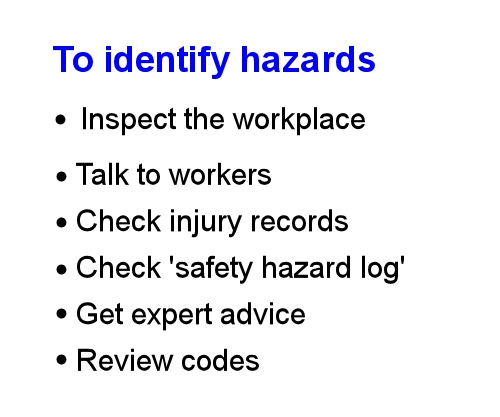Identifying hazards
 Audio for slide 1 (mp3 |6|KB)
Audio for slide 1 (mp3 |6|KB)
A hazard is anything that might harm the health or safety of someone.
Depending on where you're working, it could include airborne dust, sharp blades, obstacles, electrical currents, vehicles, noise, chemical fumes, or anything else that might cause an injury or illness.
The most obvious way to identify hazards is to go out into the workplace and look for them. But there are other methods of finding potential hazards.

Depending on where you're working, it could include airborne dust, sharp blades, obstacles, electrical currents, vehicles, noise, chemical fumes, or anything else that might cause an injury or illness.
The most obvious way to identify hazards is to go out into the workplace and look for them. But there are other methods of finding potential hazards.


Learning activity
Audio 3 (mp3 |6|KB)To be effective at identifying hazards, you need to know what sorts of injuries tend to be associated with particular types of work.
Have a look at the statistics table linked below to see what the most common injuries are in the manufacturing and furnishing industries, and the main causes of those injuries.
Have you or your work mates ever suffered from any of these injuries? Think about the causes and any changes made afterwards to the way the job was done. Did these changes reduce the chance of the injury happening again?

 Go to Assessing risks
Go to Assessing risks